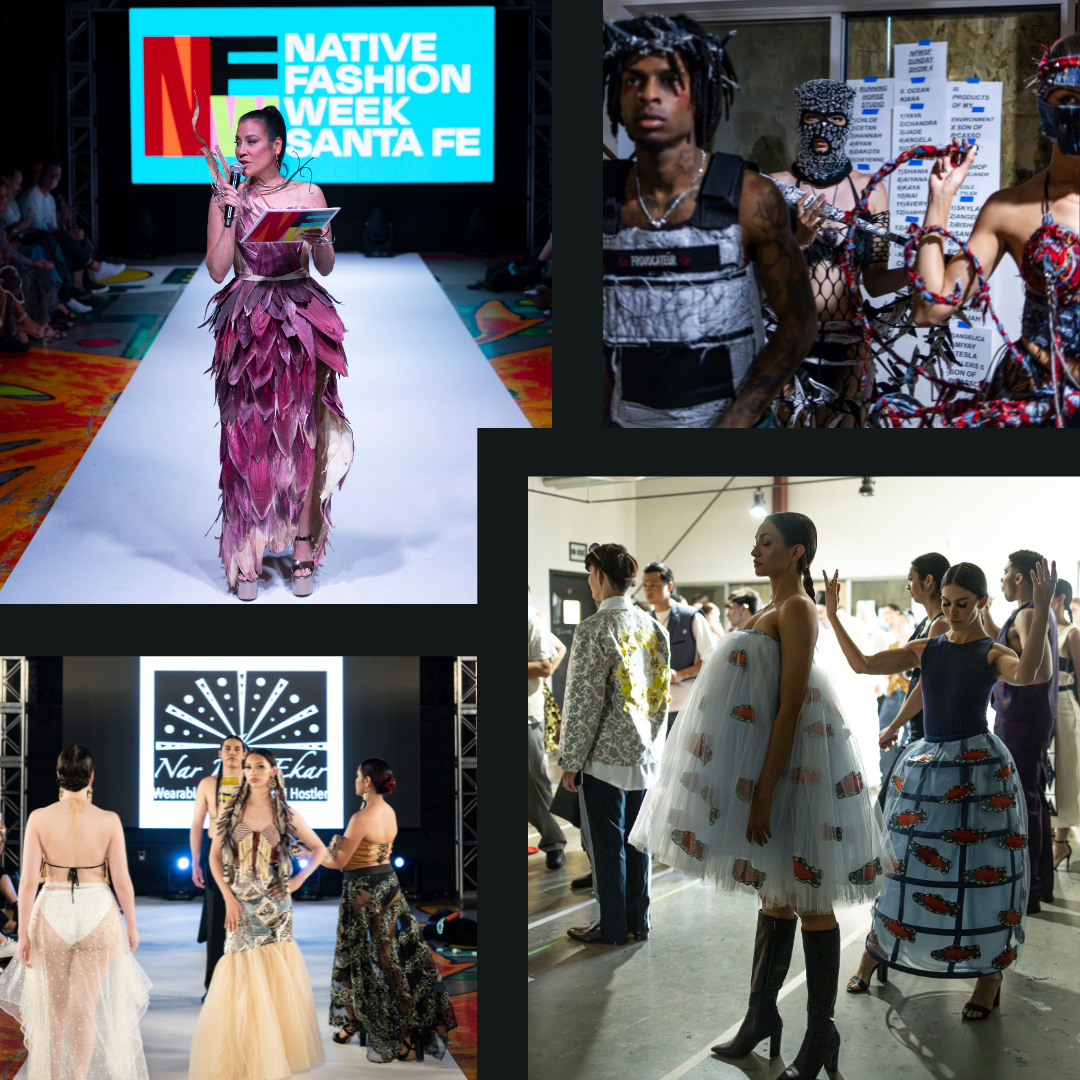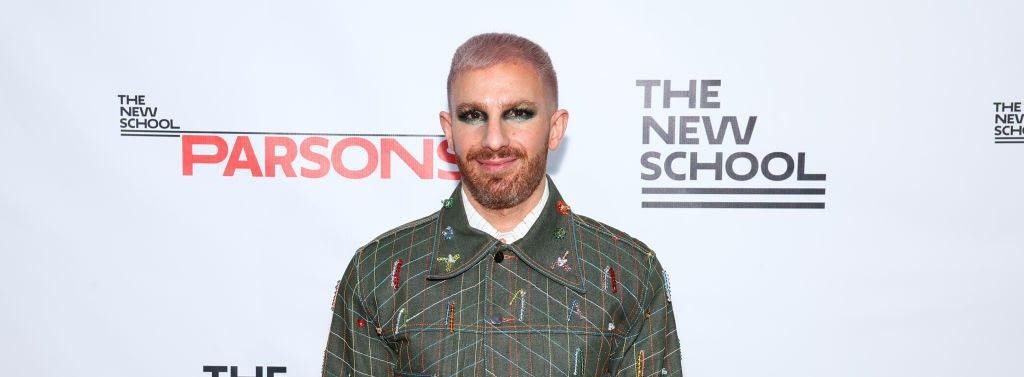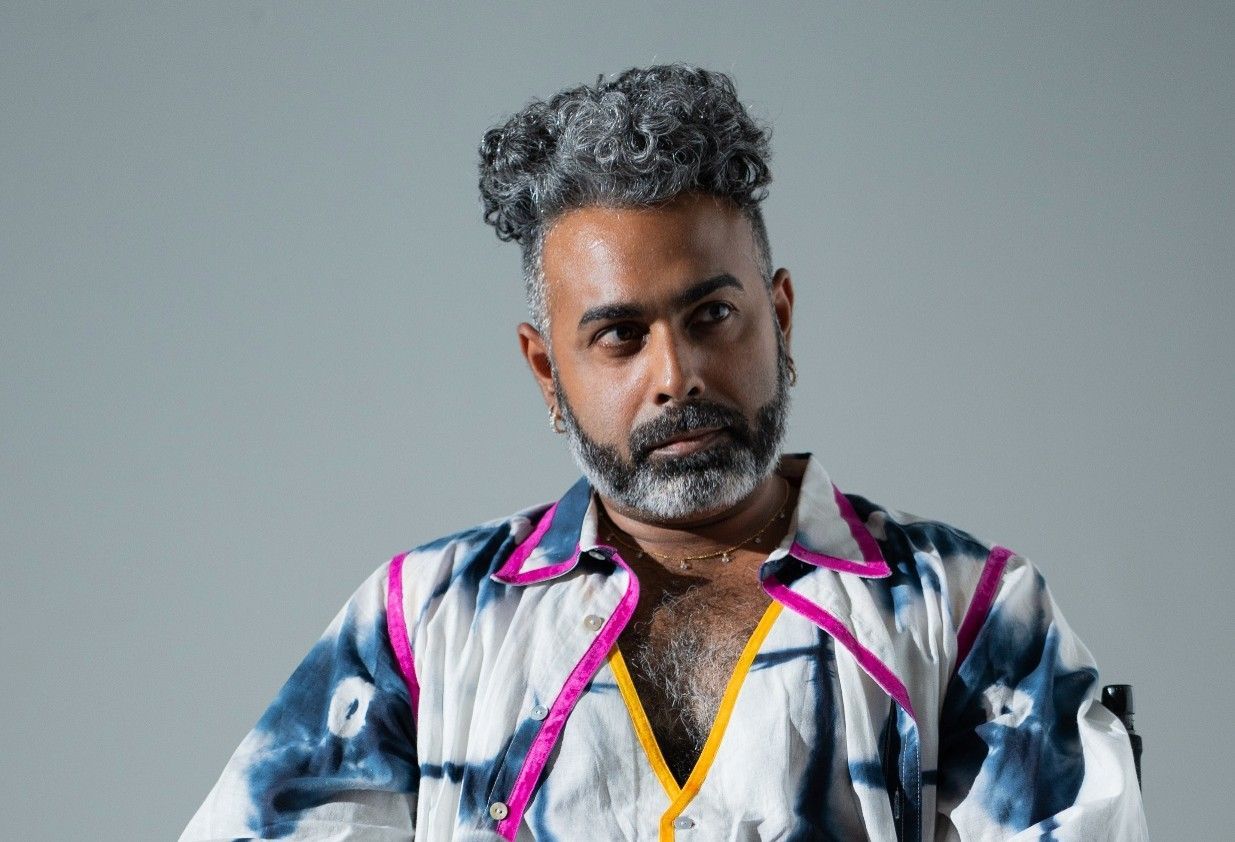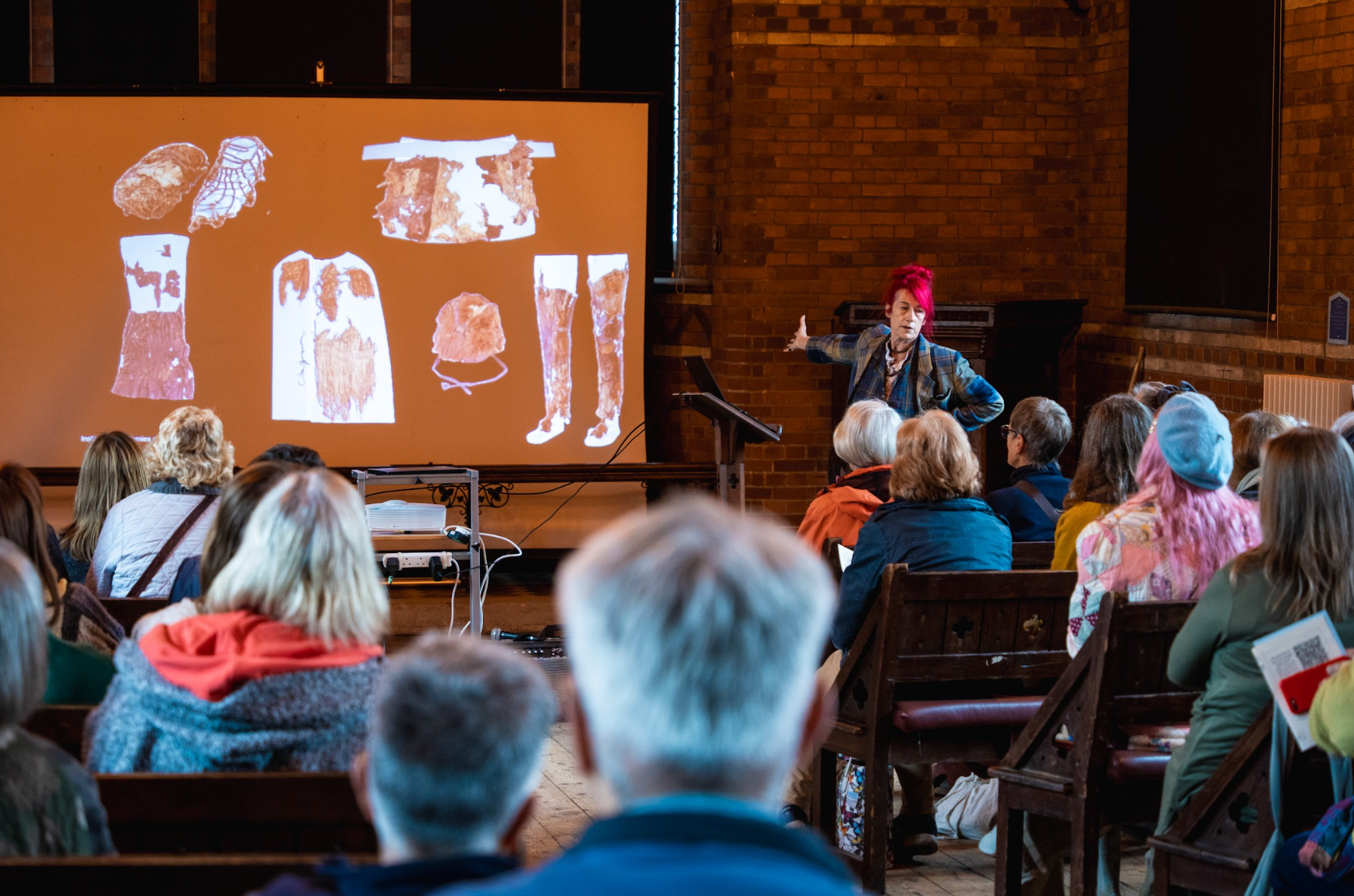Dialogues on Dress: Amber-Dawn Bear Robe
This month, we spoke with Amber-Dawn Bear Robe, Indigenous Fashion Curator and Founder & Creative Director of Native Fashion Week™.
The history of dress and the future of fashion act in dialogue, always interfacing to inform our present moment. The Costume Society of America’s diverse members exemplify this reality like no other; through the constant connections across time and disciplines they draw, our membership of costume curators, designers, artists, and so much more embody fashion’s ubiquitous presence - and dress’s daily power to teach us all something new.
We hope you will join us for CSA’s new Dialogues on Dress series, interviews now available monthly in our e-News and here on our website.
Interested in getting in touch? Email enews@costumesocietyamerica.com

Dialogues on Dress: Amber-Dawn Bear Robe
Indigenous fashion is not a field of mere artifacts. This is, first and foremost, the takeaway from a conversation with Amber-Dawn Bear Robe, a genuine maverick in the world of dress at large; you may have heard her on a recent episode of Dressed: The History of Fashion, read about her in Forbes earlier this summer, or seen her work with Native Fashion Week on Vogue Runway’s Instagram. Amber-Dawn has fervidly lifted Indigenous fashion to a new public level since her first Native Fashion Show back in 2012, and continues to turn the hackneyed narratives and clichés that surround the field on their head. As she puts it, “the American Indian has really been frozen in time, in terms of what they symbolize to the rest of the world.” Too often studied as solely anthropology, not studied at all, or simply not seen with the same expectations of dynamism, diversity, and significance we readily possess elsewhere. But with Amber-Dawn’s passion at work, their frozen position in our cultural consciousness is thawing, and with it their true complexity and relevance comes into view. Native fashion is nothing new, Amber-Dawn citing Native artists as “the original courtiers of America,” but hopefully the consideration we give it can be. With her curation, show directing, producing, teaching, and much more, Amber-Dawn’s work is helping the public peel back the many layers and stories of Indigenous fashion through the present day and into the future, one in which “Indigenous fashion is not a niche, but part of the mainstream conversation of fashion.”
Read our conversation below. This interview has been edited and condensed for clarity.
___________________________________________________
Could you please introduce yourself to our CSA readers, and paint a sketch of your background, personal and professional?
I am from Siksika Nation and my Blackfoot name is Many Butterfly Woman. I am an Indigenous Fashion Curator, focusing on Native fashion artists from across Canada and the US. Out of high school, I went to art college in Canada, the Alberta University of the Arts. I wanted to go to Parsons and be a fashion designer, but for a young Canadian girl like me, that was expensive and far away. I ended up getting a Masters in Native American Studies and a second Masters in Art History, both from the University of Alberta. But some of the greatest educational experiences that I have had have been outside of academia. The Banff Center for Art was a game-changer for me early on in my curatorial career. I just keep following my passion, wherever that leads, and I am lucky to have the flexibility to move from place to place.
And where has that passion led you these days?
I look at my curatorial career as extending from the exhibition space to the runway. It also involves scholarship, publishing, panels, and beyond, on top of teaching and curriculum-creation. I’ve been working in this world of contemporary Indigenous art since graduating from college, and that transitioned into fashion over time. For this last Native Fashion Week [Amber-Dawn launched this in 2025 under Bear Robe LLC. The first one she launched under the Southwestern Association for Indian Arts in 2014], CFDA CEO Steven Kolb came out and was our conversation lead with one of the designers. My work on Native Fashion Week is continually and rapidly growing, and on top of that I have three exhibitions coming up. One is at the Textiles Museum of Canada in Toronto, looking at the controversies and conversations in Native fashion; every garment has a story, and we’re looking at the very-public dialogues surrounding certain pieces, such as appropriation, but also those conversations within our own community, something the general public perhaps hasn’t considered much. The second exhibition is a fashion one at the James Museum in Florida, and the third is at the Brooks Museum in Memphis, Tennessee.
~I consider curating to be an artistic expression of my love for fashion, and a way to feed it rather than constantly changing or cultivating my own personal style.~
What prompted your transition from contemporary Indigenous art at large to specifically fashion?
I was very much influenced in graduate school by one of my colleagues and good friends, Jessica Metcalfe - she is one of the first people to ever get a PhD in Native fashion. Our paths kept crossing; the Native community is small, let alone within the arts and then fashion within that, and the people I’ve met throughout my work in the art field have all merged into this really beautiful, vibrant community. The shift also happened when I moved to Santa Fe, New Mexico, which is really the hub. There is high demand here for this field of study, plus it has a lot of history. It just made sense. In 2012, I produced my first fashion show there at the Museum of Contemporary Native Arts, later bringing this to The Southwestern Association for Indian Arts in 2014. Native Fashion Shows had always happened at Indian Market in Santa Fe, but I created a modern show with official programming and grew it as one of the most anticipated events at the Market. I recently launched Native American Fashion Week on my own under Bear-Robe LLC; this allows me full curatorial freedom, in turn enabling designers to have their complete artistic freedom, not hobbled by any expectations of what Native fashion should look or be like. I want to be clear that Native fashion existed way before myself, of course. I just lifted it to a different public level.
I would love to hear how you would characterize your relationship to dress over the years. How has fashion influenced your work as well as personal journey?
I want to be careful with my words, because I in no way support fast fashion, but there are many creative ways to garner new clothes and swap out old ones. Have a clothing swap party with your friends. Go second-hand shopping. But it can really depend on the luxury of where you live; if you live in NYC, you’ll have a very different experience second-hand shopping then perhaps elsewhere. Santa Fe is also an amazing place for second-hand. But honestly, you can’t underestimate the good quick-fix of going to a T.J. Maxx.
What is typical Santa Fe style?
A lot of turquoise and silver, cowboy influence, frilly white dresses. Definitely not me, not that there is anything wrong with it! The cliché Santa Fe style is heavily borrowed from Native arts and culture, but actual Native style is definitely not that. You will see lots of alternative looks in Santa Fe too - there is simultaneously a lot of anti-Southwest style here mixed in with the clichés.
~This is really the goal - to bring Indigenous fashion outside of its niche and into the public eye, and to make this an economic driver and force for Indigenous designers to continually pursue their work.~
You’re a curator, professor, fashion show director, and more (including on the board of CSA’s Dress)! Can you tell me about how you balance all these different facets of your career?
I have a great team behind me, which has become entirely essential. My support network is central to everything I do. This work is constant relationship-building and so community-oriented, but also involves networking with people outside of the community. This is really the goal - to bring Indigenous fashion outside of its niche and into the public eye, and to make this an economic driver and force for Indigenous designers to continually pursue their work. This is my passion; I just live and breathe Indigenous fashion, in all of its vortexes and trajectories, all day, every day.
Describe a typical day of work or studies (& perhaps some leisure) - or if no day looks the same, describe a good one.
If I’m ramping up for a fashion show or week, my day is just work nonstop until I collapse at night. But a typical day right now is actually what a lot of people are probably doing: getting up and being on my laptop all day. It is not necessarily that glamorous. But what I love about my job is the social component. A large part is the mixing and the mingling, keeping my finger on the pulse of what is happening. A lot of the job is social work and just conversations that don’t involve being on a laptop, which is great. My whole environment, professional and personal honestly, is centered around representing Indigenous fashion beyond just the Native bubble.
I would love to hear about your experience launching the first Indigenous fashion show on your own. What inspired you to do that, and what do you hope is the impact?
The inspiration was that I was capped at what I could do once a year at the Santa Fe Indian Market for those fashion shows. I needed to grow and expand the footprint. Hopefully this work will plant some seeds that will grow and flourish for future generations. The greatest part is just to see and feel the energy of the community, the runway room vibrates with excitement, and the high is incredible. My team and I are working on next year right now, which currently involves a lot of the unsexy work like logistics and finances.
Who are some of your favorite indigenous designers, contemporary or otherwise?
Jontay Kahm, he is a former student of mine who has just graduated from Parsons. Another Canadian designer is Jason Baerg. Up and coming designer Alex Vigil. And Shoshoni Hostler.
Are you currently teaching, and what do you enjoy about that part of your job?
I am not teaching right now, but Parsons in NYC just offered me a tenured position, which I am planning on accepting. I teach Native art history and Indigenous fashion history, and I developed a lot of my own curriculum for the latter. In teaching, I love the conversations that happen with up-and-coming generations. Native fashion is a baby in the field of fashion history - its existence is certainly not, but the academic study of it is. Native fashion is not new, but framing it in this academic, scholarly environment is. As a teacher, I have the opportunity to inspire students to change the narrative.
~ So much scholarship and research need to be done to move beyond this purely ‘anthropological’ lens. The American Indian has really been frozen in time, in terms of what they symbolize to the rest of the world, and that is the narrative that needs to be changed. Coming from the perspective of fashion is just one way to do that. ~
Changing the narrative - can you expand on that?
I consider Native artists the original courtiers of America. I use the term haute couture, because that is a language people understand. Historically, Native fashion has been framed through the lens of "anthropological objects," rather than fashion. So much scholarship and research need to be done to move beyond this purely ‘anthropological’ lens. The American Indian has really been frozen in time, in terms of what they symbolize to the rest of the world, and that is the narrative that needs to be changed. Coming from the perspective of fashion is just one way to do that.
Over the next five years, how do you see your work evolving? Tell me about a dream project, a vision, or general directional mood…
The next five years are full of Native Fashion Week, exhibition work, and growing the Indigenous fashion department of Parsons. Also hopefully growing our sponsorships and fundraising, such as ideally finding a major sponsor for Fashion Week, since these things cost money. So, I have both financial and curatorial goals. And I am excited to be in New York, the center of the world, let alone the American fashion world. The opportunity to make a big impact there is a really exciting possibility. I would also love for my team to have a big presence at New York Fashion Week.
What does the future of fashion look like to you?
Indigenous fashion is not a niche, but part of the mainstream conversation of fashion. That also means that a lot of the economic success goes back to these designers to have major fashion houses.
___________________________________________________
Thank you so much to Amber-Dawn Bear Robe for having this conversation with me! Check out her work here, and the current exhibition Future Imaginaries, which Amber-Dawn co-curated, at the Autry Museum of the American West. Follow her work here!
https://www.nativefashionweeksantafe.com/
https://www.nativefashionweekworld.com/
~Madison Brito Taylor
Photos courtesy of Tira Howard (@tirawan)



